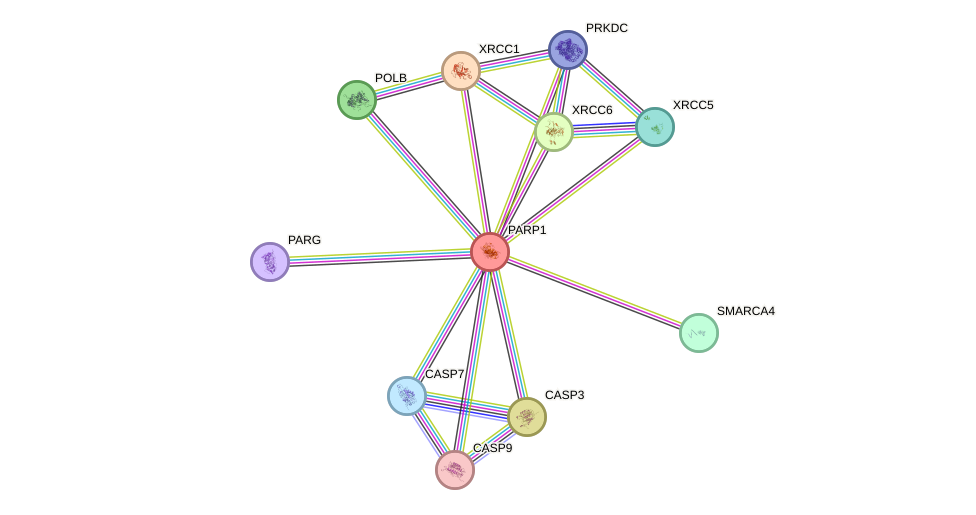GenAge entry for PARP1 (Homo sapiens)
Gene name (HAGRID: 60)
- HGNC symbol
- PARP1
- Aliases
- PARP; PPOL; ADPRT
- Common name
- poly (ADP-ribose) polymerase 1
Potential relevance to the human ageing process
- Main reason for selection
- Entry selected based on evidence linking the gene product to a pathway or mechanism linked to ageing
- Description
The PARP1 enzyme catalyses the transfer of ADP-ribose to a variety of nuclear proteins including members of the high mobility group box and topoisomerase families [984]. It is involved in a variety of processes such as proliferation, differentiation, and recovery from DNA damage [407]. PARP1's levels appear to inversely correlate with mammalian lifespan and PARP1 has been hinted as a determinant of mammalian ageing [68]. PARP1 is a critical mediator of axon growth inhibition. Pharmacological inhibition or genetic loss of PARP1in mouse cells markedly facilitates axon regeneration, thus making PARP1 a potential target to reverse neurological disability [4346]. Nonetheless, more detailed studies are necessary to investigate a role for PARP1 in ageing.
Cytogenetic information
- Cytogenetic band
- 1q41-q42
- Location
- 226,360,691 bp to 226,408,100 bp
- Orientation
- Minus strand
Protein information
- Gene Ontology
-
Process: GO:0000122; negative regulation of transcription from RNA polymerase II promoter
GO:0000715; nucleotide-excision repair, DNA damage recognition
GO:0000717; nucleotide-excision repair, DNA duplex unwinding
GO:0000724; double-strand break repair via homologous recombination
GO:0006273; lagging strand elongation
GO:0006281; DNA repair
GO:0006293; nucleotide-excision repair, preincision complex stabilization
GO:0006294; nucleotide-excision repair, preincision complex assembly
GO:0006295; nucleotide-excision repair, DNA incision, 3'-to lesion
GO:0006296; nucleotide-excision repair, DNA incision, 5'-to lesion
GO:0006302; double-strand break repair
And 39 more GO terms Cellular component: GO:0000784; nuclear chromosome, telomeric region
GO:0005634; nucleus
GO:0005635; nuclear envelope
GO:0005654; nucleoplasm
GO:0005667; transcription factor complex
GO:0005730; nucleolus
GO:0005739; mitochondrion
GO:0016020; membrane
GO:0043234; protein complex
Show all GO termsFunction: GO:0003677; DNA binding
GO:0003910; DNA ligase (ATP) activity
GO:0003950; NAD+ ADP-ribosyltransferase activity
GO:0005515; protein binding
GO:0008134; transcription factor binding
GO:0008270; zinc ion binding
GO:0019899; enzyme binding
GO:0019901; protein kinase binding
GO:0030331; estrogen receptor binding
GO:0042802; identical protein binding
GO:0042826; histone deacetylase binding
And 5 more GO terms
Protein interactions and network
- Protein-protein interacting partners in GenAge
- TP53, ATM, WRN, LMNA, E2F1, HDAC3, TCF3, PARP1, BRCA1, CREBBP, HIF1A, RPA1, BLM, BCL2, ABL1, TOP2B, NFKB1, TOP1, UBE2I, CEBPA, ERCC6, EP300, APTX, PRKDC, XRCC5, PCNA, XRCC6, FOXO1, RELA, SIRT1, HDAC1, PTK2, SP1, JUN, MED1, BMI1, BUB1B, POLA1, HDAC2, H2AFX, HOXB7, ESR1, CTNNB1, POLB, BUB3, CDKN1A
- STRING interaction network
Retrieve sequences for PARP1
Homologs in model organisms
- Caenorhabditis elegans
- pme-1
- Danio rerio
- parp1
- Drosophila melanogaster
- Parp
- Mus musculus
- Parp1
- Rattus norvegicus
- Parp1
In other databases
- GenAge model organism genes
- A homolog of this gene for Caenorhabditis elegans is present as pme-1
- LongevityMap
- This gene is present as PARP1
- CellAge
- This gene is present as PARP1
- CellAge gene expression
- This gene is present as PARP1

